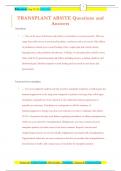1
Elscores: Aug. 27, 24- 2024/2025
TRANSPLANT ABSITE Questions and
Answers
Tacrolimus
:-- One of the most well-known side effects of tacrolimus is its neurotoxicity. This can
range from mild tremor to profound headache, confusion, and even seizure. Side effects
of prednisone include poor wound healing, striae, weight gain and central obesity,
hyperglycemia, and psychiatric disturbances. CellCept or mycophenolate mofetil is most
often cited for its gastrointestinal side effects including nausea, vomiting, diarrhea, and
abdominal pain. Sirolimus impairs wound healing and can result in oral ulcers and
pneumonitis.
3 years post liver transplant
:-- It is not completely understood why, but liver transplant recipients overall require less
immunosuppression in the long-term compared to patients receiving other solid organ
transplants, and graft loss from rejection is rare. Induction immunosuppression is
typically not necessary. Tacrolimus or cyclosporine is still the mainstay of
immunosuppressive therapy, but doses are reduced over time to minimize side effects.
10-15% of patients develop renal failure requiring hemodialysis or kidney transplantation
within ten years after liver transplantation. Malignancies are more common in post-
transplant patients, but skin cancer is the most common. Kaposi's sarcoma and
oropharyngeal cancers are rare but deadly malignancies associated with transplantation.
Opportunistic infections are most common in the first six months after transplantation,
but infection overall is still a major cause of mortality for transplant patients.
Exams and Correct Answers |Best Grades | Excellence | Success & Guaranteed Pass
, 2
Elscores: Aug. 27, 24- 2024/2025
Preservation of kidneys and livers with The University of Wisconsin (UW) solution:
:-- Permits longer cold ischemia times of >12 hours in liver transplants but with an
increase in biliary tract complications
UW solution has led to a reduction in delayed graft function after kidney transplantation but is
associated with an increase in biliary complications with preservation times >12 hours.
An advantage of placing a kidney transplant in the retroperitoneum anastomosed to the iliac
vessels is:
:-- There are a number of advantages to the placement of a kidney transplant in the
retroperitoneal space anastomosed to the iliac vessels. The exposure avoids peritoneal
contamination, provides a multitude of options for vascular reconstruction, allows for
easy percutaneous biopsy, and places the kidney close to the bladder, so the length of the
ureter can be kept short and the risk of ischemia minimized. The risk of bleeding and
infection is no smaller, nor is the approach appreciably faster, or associated with less pain
than most alternatives.
An advantage of draining the pancreatic secretions into the bladder is:
:-- The ability to monitor pancreatic function with urinary amylase
The ability to monitor pancreatic function with urinary amylase is considered an advantage of
bladder-drained pancreases. Amylase secretion is a more sensitive marker of pancreatic function
than blood glucose control. Bladder drainage is associated with higher morbidity, as patients
develop late leaks and urethral strictures. There is technically not much difference between an
enteric anastomosis and a bladder anastomosis, and there is no difference in the immunogenicity
of the graft or the likelihood of infections.
Exams and Correct Answers |Best Grades | Excellence | Success & Guaranteed Pass
, 3
Elscores: Aug. 27, 24- 2024/2025
immunosuppression meds
:-- Tacrolimus is an example of a calcineurin inhibitor that plays a role in preventing
early activation and signaling of T-cells by inhibiting IL-2 production and IL-2 receptor
expression. Steroids are relatively non-targeted immunotherapy with anti-inflammatory
properties whose full effects on the immune system are not completely recognized. Anti-
proliferative agents include nucleotide synthesis inhibitors such as azathioprine
(nonspecific) and mycophenolate mofetil (non-competitive inhibitor of inosine 5'-
monophosphate dehydrogenase (IMPDH), the rate-limiting enzyme in the de novo
synthesis of guanine nucleotides). Sirolimus is an inhibitor of mTOR signaling pathway.
Alemtuzumab (Campath) is an antibody to CD52 and plays a role in induction therapy,
targeting mature B and T-cells for destruction.
contraindication to donation
:-- Although the other characteristics listed are risk factors that can impact donor organ
quality, none are absolute contraindications. A history of malignancy in a potential donor
is concerning for cancer transmission to a potential recipient. Certain types of cancers,
such as basal cell skin cancers and CNS malignancies, may be considered as potential
donors; however, patients with advanced visceral malignancy are usually deemed
unsuitable as organ donors.
CKD stages
Exams and Correct Answers |Best Grades | Excellence | Success & Guaranteed Pass
, 4
Elscores: Aug. 27, 24- 2024/2025
:-- The disease process is relevant, as Stage 1 is defined as anatomic evidence of kidney
disease without impaired function, so for example, a patient with polycystic kidney
disease and anatomic cysts who still had a normal creatinine clearance would be defined
as stage 1. Stage 2 is a GFR between 60 and 90, Stage 3 a GFR between 30 and 60, Stage
4 between 15 and 30, and Stage 5 is < 15 or on dialysis.
A 52-year-old woman receives a cadaveric kidney transplant for hypertensive nephrosclerosis.
Thirty-six hours after surgery she has a recorded urine output of 10 mL/hr and ultimately
requires hemodialysis. A renal ultrasound reveals a normal kidney without obstruction.
:-- Ischemia-reperfusion injury results in acute tubular necrosis (ATN) or delayed graft
function requiring dialysis in less than 5% of living donor transplants, but in cadaver
transplants, the incidence is higher than 20%. In the absence of vascular or ureteral
problems, initially nonfunctional cadaver kidneys may be assumed to suffer from ATN,
especially if nuclear scans demonstrate good blood flow and poor tubular function.
Answer B: Hyperacute rejection results from preformed antibodies against the donor organ.
Within minutes of revascularization, the kidney turns blue and soon undergoes vascular
thrombosis.
Answer C: Extensive mobilization of the iliac vessels during the transplant operation or failure to
ligate the lymphatics crossing them can result in lymphoceles. Symptoms may not occur until
weeks later and consist of
swelling of the wound;
Exams and Correct Answers |Best Grades | Excellence | Success & Guaranteed Pass




